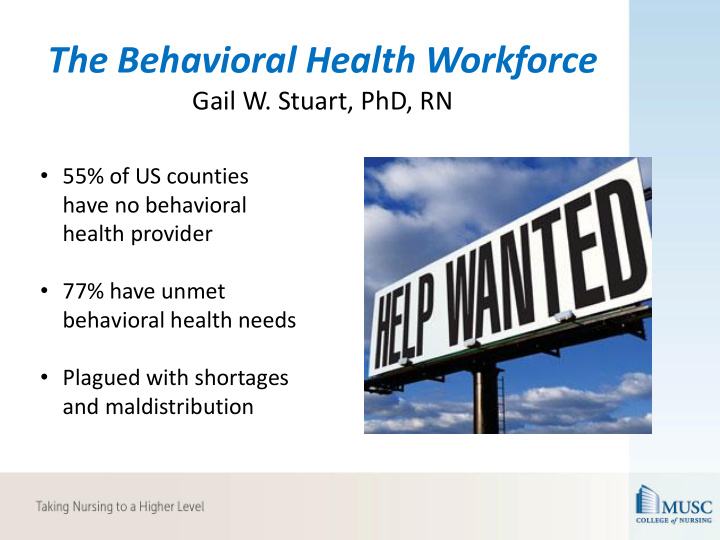



The Behavioral Health Workforce Gail W. Stuart, PhD, RN • 55% of US counties have no behavioral health provider • 77% have unmet behavioral health needs • Plagued with shortages and maldistribution
• CALL TO ACTION – 2007 • Mental health, addictions, treatment & prevention • Identified a core set of strategic goals & objectives and priority action items by stakeholder • A planning resource with levers of change 1000 points of “ NO ” WHO, WHAT, WHERE of the Behavioral Health Workforce and Policy Recommendations
1) WHO is our Workforce?
Behavioral Health Workforce
➢ We Need to Redefine the Workforce • 100,000 nurses working in mental health settings • Over 275,000 primary care clinicians • 3.8 million general nurses • Police • Peers, consumers, people in recovery • Community health workers • Families and friends
➢ We Need a Planning Data Base • Nationally adopt a minimum data set of all specialty and generalist behavioral health care providers: Michigan: Behavioral Health Workforce Research Center funded by SAMHSA and HRSA • Exemplar: New Mexico passed legislation to provide the state with behavioral health workforce data
➢ We Need to Recruit our Future Workforce and then Retain Them • Expand federal programs: • Loan forgiveness • Training programs (BHWET) • Allow for full scope of practice for all licensed/credentialed clinicians • Reimbursement for all licensed/credentialed clinicians • Fully utilize and reimburse non-behavioral health providers as core behavioral health service providers – nurses, other clinicians, peers, community health workers
2) WHAT type of care is provided?
➢ We Need to Rethink our Treatments • Reimburse only Evidence-Based treatments inclusive of “non - traditional” care – trauma- informed, recovery support, care coordination • Expand fee-for-service limitations in primary care from 10-15 minute appointments • Eliminate prohibiting same-day and two- generation services • Reimburse specialty trainees for care provided
➢ We Need to Rethink our Treatments • Move beyond medications into psychosocial interventions • Implement new processes of care – simple, standardized, automated screening tools • Triage patients to most appropriate care-giver based on symptom severity and type and intensity of service needed
➢ We Need to Rethink our Treatments • Opioid Crisis – 47% US counties and 60% rural counties have no MAT prescriber • Eliminate the waiver process for MAT prescribers by including it in training programs • Eliminate waiver requirements for those who can prescribe controlled substances • Make MAT an essential health benefit • Ensure insurance parity
3) WHERE is Care Provided? • Hospitals • Clinics – siloed and/or integrated • Outpatient offices • Medical Homes • Sometimes Mobile Crisis Units • Sometimes Crisis Stabilization and/or Detox Units • Most settings are 9-5 on weekdays • And so the ER is now a primary point of behavioral health care
➢ We Need to Rethink our Settings • Churches • Community Center • Work places • Prisons • Schools • Homes • And coming NOW is “anytime, anywhere” behavioral health care with eHealth, mHealth, telehealth and telesupervision
So, at the End of the Day….. We need the right workers with the right skills in the right place doing the right thing Thank you!
Recommend
More recommend